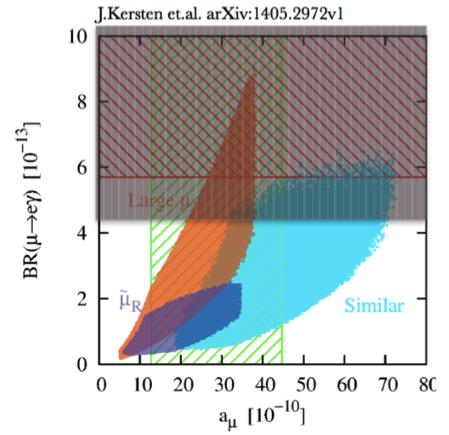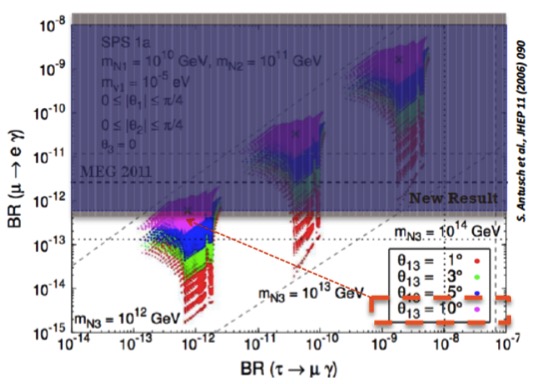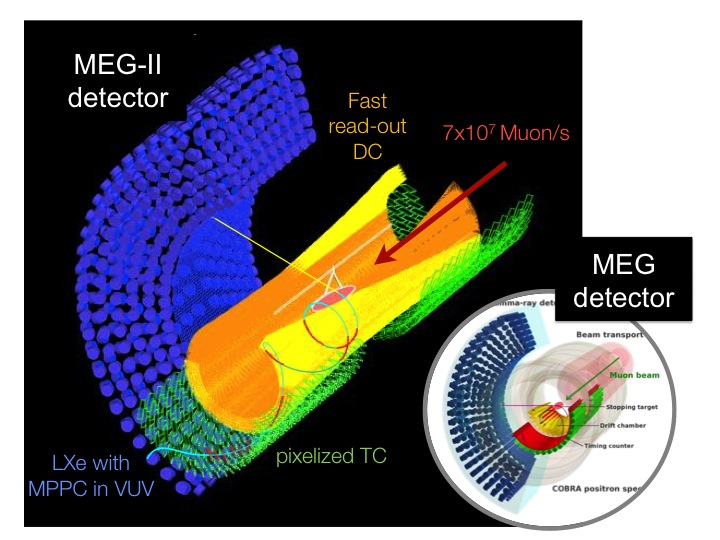 |
The MEG(-II) Experiment |
||||||||||||||||||||||||||||
 |
|||||||||||||||||||||||||||||
|
|
|||||||||||||||||||||||||||||
|
The international collaboration MEG (Italy, Japan, Switzerland, USA, Russian) searches for the decay μ+->e+γ al Paul Scherrer Institut (Zurich).
This decay, practically forbidden in the Standard Model of particle physics, is foreseen in many extensions of this model at an experimentally accessible level. The observation of μ+->e+γ would be a clear signal of New Physics while stringents contraints allow to set limits on the parameters space of new theoretical models or even to exclude some of them. The pictures below show the predictions for μ+->e+γ for two New Physics models (MSSM and SUSY with see-saw respectively). As it can be seen already the present MEG result set rather stringent limits on the parameters space. 

Since it is a very rare decay (if it exists) it is necessary to have a very intense muon beam; at PSI the most intense continuous muon beam in the world is available, up to 108 muons per second. The MEG experiment places itself at the intensity frontier of New Physics searches, complementary to the energy frontier (LHC). The MEG final result, based on the analysis of the data taken in 2009-2013 is: BR(μ+->e+γ) < 4.2 x 10-13 @90% C.L. ( EPJC76,8,434 (2016)). It is the world best limit on this decay. The MEG experiment has been upgraded and is in the data-taking phase; In a special seminar at the Paul Scherrer Institut (PSI) in Switzerland, the MEG II Collaboration presented on Oct. 20th 2023 its first results about a new search for this process, based on data collected in 2021, and the results was submitted to European Journal of Physics C (link). By combining this result with the previous result from MEG, an improved upper limit of BR(μ+->e+γ) < 3.1 x 10-13 @90% C.L has been obtained. The experiment is still taking data since 2021 and a twenty-fold increase in statistics is foreseen by 2026, with the goal to improve the sensitivity to the decay probability by one order of magnitude with respect to MEG. Below a scheme of the MEG and MEG-II detectors is shown. The muon beam is stopped by a thin plastic target and decays at rest: a photon and a positron are searched, emitted simultaneously, back to back, with an energy equal to half of the muon mass. The positron is reconstructed in a spectrometer (drift chamber, DCH, in a magnetic field) and then its time is measured by scintillator detectors (timing counters, TC); the photon is detected using a very large liquid Xenon calorimeter. 
| ||||||||||||||||||||||||||||
 |
|||||||||||||||||||||||||||||
